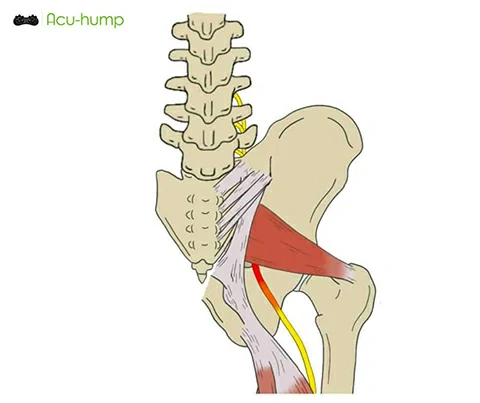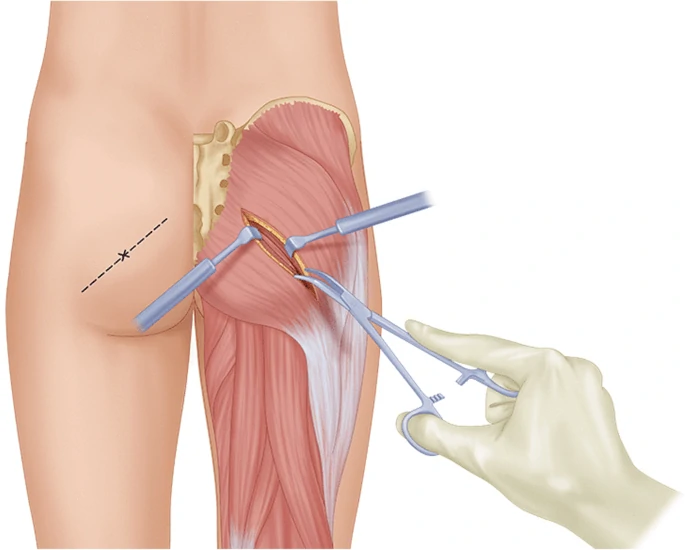Piriformis syndrome is a condition that can significantly impact an individual’s daily life and physical functionality. Characterized by pain and discomfort in the buttocks, hip, and lower back, this syndrome often causes symptoms similar to those of sciatica. In this article, we will explore the causes, symptoms, and treatment options available for Piriformis syndrome.
What is Piriformis Syndrome
Formerly known as wallet sciatica or fat wallet syndrome, piriformis syndrome occurs due to the long-term and/or excessive contraction of the piriformis muscle.
Further research has confirmed that many areas within the deep gluteal space may potentially impinge the sciatic nerve. This led to the introduction of the term deep gluteal syndrome (DGS) to better distinguish the pathophysiology and clinical symptoms of hip and gluteal pain, as well as nerve root pain caused by non-discogenic sciatic nerve and extra-pelvic entrapment.1
It is a condition that occurs when the piriformis muscle, located deep in the buttock region, becomes tight or spasms. This muscle plays a crucial role in hip rotation and stability. When it becomes irritated or inflamed, it can compress the sciatic nerve that runs beneath or through it, resulting in pain.
Causes of Piriformis Syndrome
The piriformis muscle, located in the buttocks, plays a crucial role in movement and stability. When this muscle tightens or undergoes trauma, it can result in Piriformis syndrome. Other factors, such as anatomical abnormalities or overuse, can also contribute to the development of the condition. Identifying the underlying causes is essential for appropriate treatment and management.

Symptoms of Piriformis Syndrome
Piriformis syndrome often presents with a wide array of symptoms, including persistent pain and discomfort in the buttocks, hip, and lower back. However, one distinguishing factor is pain that radiates down the leg, mimicking the symptoms of sciatica. Additionally, individuals may experience numbness, tingling, or weakness in the affected leg. Understanding these symptoms can aid in prompt diagnosis and treatment.
Diagnosis of Piriformis Syndrome
Accurately diagnosing Piriformis syndrome can be challenging due to overlapping symptoms with other conditions like herniated discs or spinal stenosis. A comprehensive evaluation, including a physical examination, medical history review, and imaging tests, is essential to rule out alternative diagnoses. This thorough diagnostic process can lead to effective and targeted treatment plans.
Treatment Options for Piriformis Syndrome
Several treatment options are available for Piriformis syndrome, with conservative approaches being the initial focus. The following are commonly utilized:
Rest and Activity Modification
Resting the affected area and avoiding activities that worsen symptoms can help alleviate pain and promote healing. Limiting high-impact activities and maintaining good posture can also aid in recovery.
Hot or Cold Therapy
Applying heat or cold to the affected area can provide temporary relief from pain and reduce inflammation. Heat therapy improves blood flow and relaxes muscles, while cold therapy helps numb the area and reduce swelling.
Physical Therapy
Physical therapy exercises play a pivotal role in strengthening the piriformis muscle and improving flexibility. These exercises may include stretches, strengthening exercises, and targeted movements to alleviate pressure on the sciatic nerve.
Medications
Doctors may recommend non-steroidal anti-inflammatory drugs (NSAIDs), such as ibuprofen or naproxen, to manage pain and reduce inflammation. These medications can provide temporary relief and improve overall comfort.
Massage Therapy
Massage therapy can help relax the piriformis muscle and relieve tension in the surrounding area. Techniques like deep tissue massage or trigger point therapy can target specific areas of tightness or discomfort.
Acupuncture
It is also called dry needling, an ancient Chinese healing practice that involves the insertion of thin needles into specific points on the body. Acupuncture may help alleviate pain, reduce muscle tension, and improve overall well-being in individuals with Piriformis syndrome.
Stretching Exercises
Stretching exercises can be beneficial for individuals with piriformis syndrome. One commonly used stretch is the figure 4 stretch. However, for effective stretching, it is also important to relax the muscles surrounding the piriformis. Here, we recommend a 10-minute stretching routine that targets six areas from the lower back to the hips for relaxation.
Acu-hump
One alternative treatment option that has gained attention is the Acu-hump tool. This tool, often used in conjunction with massage therapy, targets trigger points within the piriformis muscle. By applying pressure to these specific points, the Acu-hump tool can help release tension, reduce muscle tightness, and relieve pain.

Acu-hump®
Release Butt & Lower Back
Exercises for Piriformis Syndrome
In addition to stretching exercises, strengthening exercises can also help treat piriformis syndrome. The focus is on strengthening muscles, including the glutes, lower back, and core muscles. These exercises help improve stability and alleviate pain associated with piriformis syndrome.
It’s essential to remember that treatment should be individualized, and what works for one person may not work for another. It is advisable to work closely with healthcare professionals to develop a personalized treatment plan that addresses your unique needs and goals.
Surgical Intervention
In rare cases where conservative methods fail to alleviate symptoms, doctors may consider surgical intervention. They can perform procedures such as piriformis muscle release or decompression to alleviate compression on the sciatic nerve. However, surgery is generally considered a last resort and doctors reserve it for severe or refractory cases.

In conclusion, Piriformis syndrome can cause distressing symptoms that greatly impact an individual’s well-being. Early diagnosis and prompt treatment are crucial in managing the condition successfully. Through a comprehensive approach, including conservative treatments, physical therapy, Acu-hump massage tool, medications, and, if necessary, surgical intervention, individuals can achieve relief and regain their functionality. By understanding the causes, symptoms, and treatment options available for Piriformis syndrome, medical professionals and patients alike can work together towards a brighter outlook and improved quality of life.
